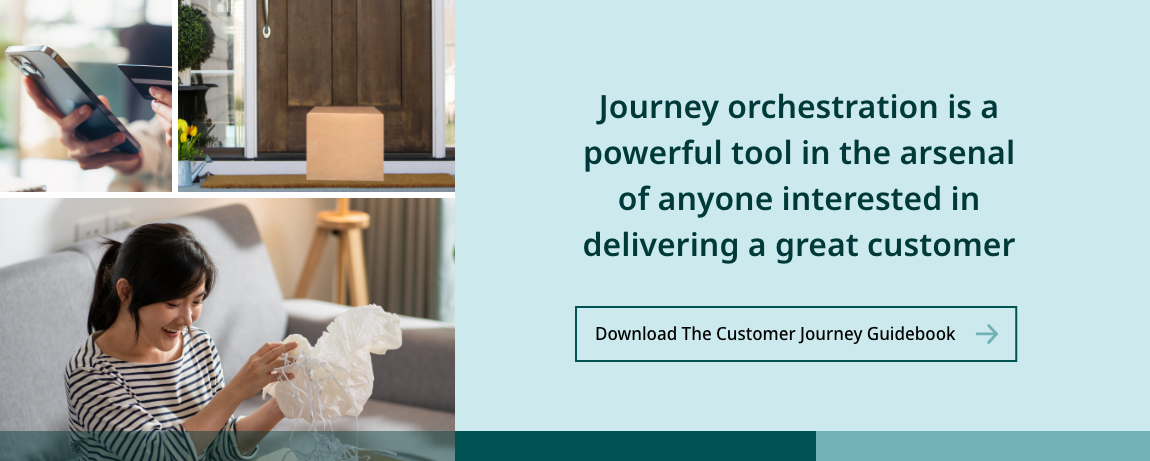Customer service professionals have one of the toughest jobs out there, often only talking with people when things go wrong. To deliver a great experience, they have to protect their customers’ time and solve their problem.
In response, customer service professionals need all of the help they can get to deliver great experiences. The potential payoff is huge, especially because businesses that have a great customer experience outperform laggards by up to 80 percent. Customer service is just one part of the customer experience, but plays an important role in keeping customers satisfied.
Customers today expect real-time results, to be helped on the first call, and to receive a personalized experience. Journey orchestration is the practice of delivering these results. This makes it the most impactful way to deliver great service experiences in real time. By looking at the customer lifecycle holistically, it’s possible to deliver better experiences.
Traditionally, businesses have simply dealt with the customer on a case-by-case basis, and only look at the information relevant to their particular claim or inquiry. A journey approach uses a system that collects data from across the business and updates systems and channel communications automatically. This avoids confusing customers and delivers better value. The following journey orchestration use cases are some of the most powerful that we’ve seen for customer service.
1. PROMPT CONVERSIONS WITH RELEVANT SUGGESTIONS
People expect customer service to be able to resolve their issues and give good recommendations for how they should proceed. Despite the adage that service is selling, customers often don’t see it this way. To deliver a great service experience, you need to be able to seamlessly offer the right solution to customer’s problems. Sometimes that may include a premium upgrade or a different product, but knowing when to make that recommendation is a key part of delivering a great experience.
With customer journey orchestration, you can immediately pull up the best next product for a customer based on not only your knowledge, but also information that provided given through web activities, previous calls or even advertising interests.
2. TEMPORARILY SUPPRESS YOUR MARKETING
An unfortunate truth is that we often receive ads for products that have already been purchased, or receive an upbeat friendly email just after our relationship with the company has suffered a setback.
With a seamlessly connected, real-time customer journey, CX and customer service professionals can immediately push suppression across their advertising channels and marketing email campaigns. This can be crucial when a customer needs a white glove treatment. Unfortunately, customers can sometimes act rashly and unsubscribe or block ads while they are angry. A customer journey empowers customer service to deliver a more tailored experience and prevent those negative actions.
3. MAKE CUSTOM OFFERS WHEN THINGS GO WRONG
Sometimes, despite customer service professionals’ best efforts, the problem can’t be fixed. Whether a package will be unavoidably late or another inconvenience can’t be helped, it can mean a serious problem for the relationship of a person with the brand. Often, a gift card, credit or similar offer is sufficient to mend the relationship. When it isn’t, an integrated customer journey orchestration system empowers customer service professionals to have dynamic offers ready for customers in crisis.
Because customer journey systems integrate the entire customer lifecycle, you can offer a relevant service or product that they may need because of their order history. For example, if a person buys new shoes from your website every six months, it may be cheaper to waive shipping fees on the next two orders than provide a $25 gift card in the moment. However, the customer will feel the value more directly because it makes their next year of orders worry-free. This is only possible if you have a view of the customer’s behavior across time.
4. PROVIDE INTELLIGENT HELP WITH IOT
With more devices and systems connected to the Internet of Things (IoT), customer service has a growing ability to predict and prevent issues rather than simply reacting to problems as they happen. For example, in modern cars, it’s often possible to know when something will go wrong before a part completely breaks. This can mean customer service is in the unique position of potentially saving a life!
Taking action to inform the customer and offer to fix the problem before it ruins their day can take a potentially bad situation and turn it into a true value-add. Whether it’s toasters, TVs, automobiles or any other product that integrate with IoT, these devices can provide valuable information for customer service so long as that data is being collected and analyzed in real time.
5. PREVENT SOCIAL MEDIA MOCKERY
Even the best customer service pros have bad interactions with customers from time to time. Whether some piece of information was missed or the customer isn’t understanding, this can lead to social media outbursts.
With real-time orchestration integrated with a social media listening system, your agents or representatives can know when someone is talking about them online. If someone tweets that they’ve been on hold for an hour, then you can prioritize their call. This is only possible if you’re orchestrating a connection between their social handle and phone number.
As someone willing to utilize social media to get your attention and complain, they can create an injurious view of your brand if they’re not helped quickly. On the other hand, customers may unknowingly have left clues as to the reason for their problem online. With an intelligent system that knows what to look for and powerful journey decisioning to back it up, your team can deliver even better service experiences.
6. KNOW WHAT’S ALREADY BEEN PROMISED
One of the worst service experiences for a customer is to receive different pieces of information from different people. Even if they eventually find the correct information or have their issue resolved, it’s deeply frustrating to be told different things each time they call. One reason for this frustration is that customers value their time above almost all else. This makes it critical to know what has already been promised to save time. A customer journey orchestration tool can have a huge impact on delivering great service experiences.
With simple tracking and recording practices, customer service representatives can relay information in real time. Even representatives from different parts of the business can coordinate so that each future contact knows what has been discussed. Better still, with intelligent real-time flagging and check-ups, service representatives can know what has happened in other departments. This empowers not only customer service, but everyone from fulfillment to sales and beyond.
By measuring, you can also see which service experiences are happening more frequently. This then gives customer service the ability to identify new UX and experience improvements for your brand overall. Taken together and powered by real time journey orchestration, this allows for the delivery of consistent experiences that thrill customers.
CONCLUSION
The world of customer service is at a tipping point. To deliver great customer service experiences, it’s becoming necessary to be better informed, and faster acting than ever before. The information for your customer is out there, hiding in different parts of previous conversations, on the internet, or elsewhere in your business. With customer journey orchestration, you can bring it all in a singular, data-driven view.

